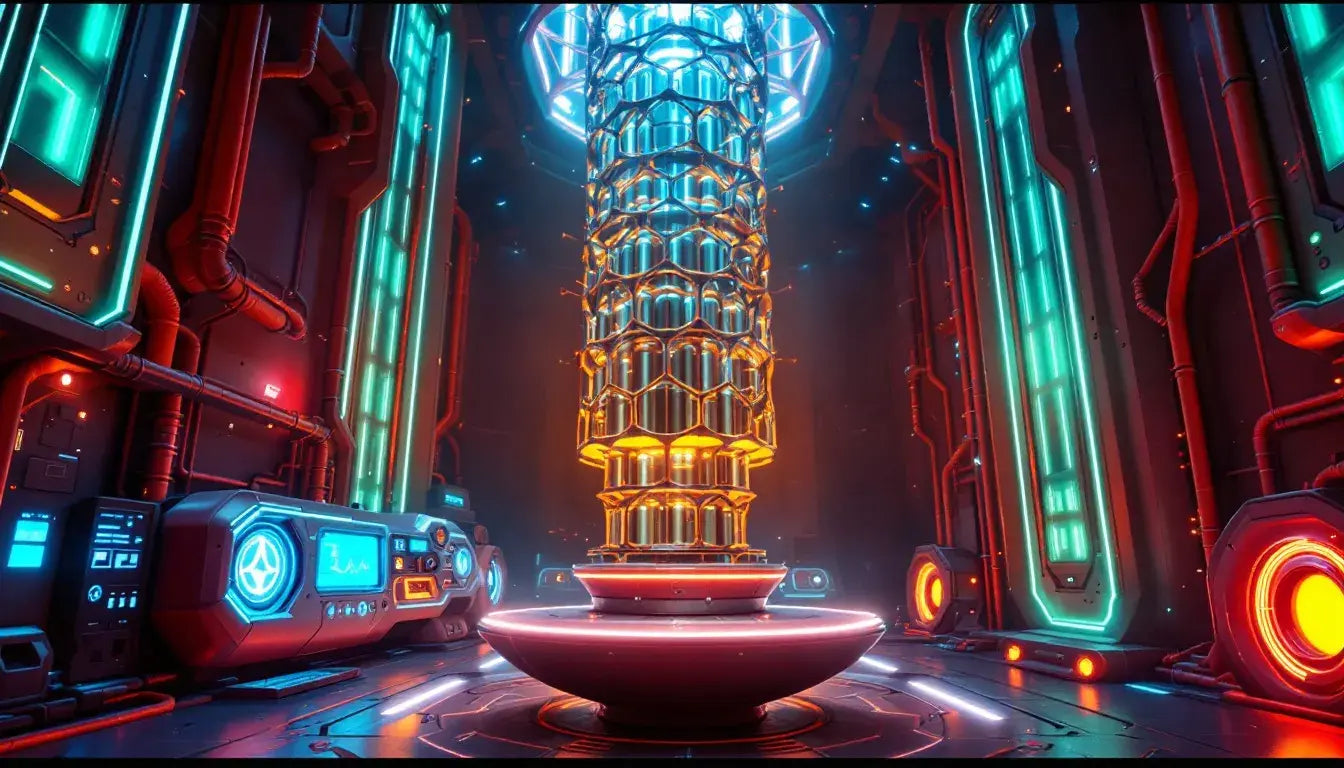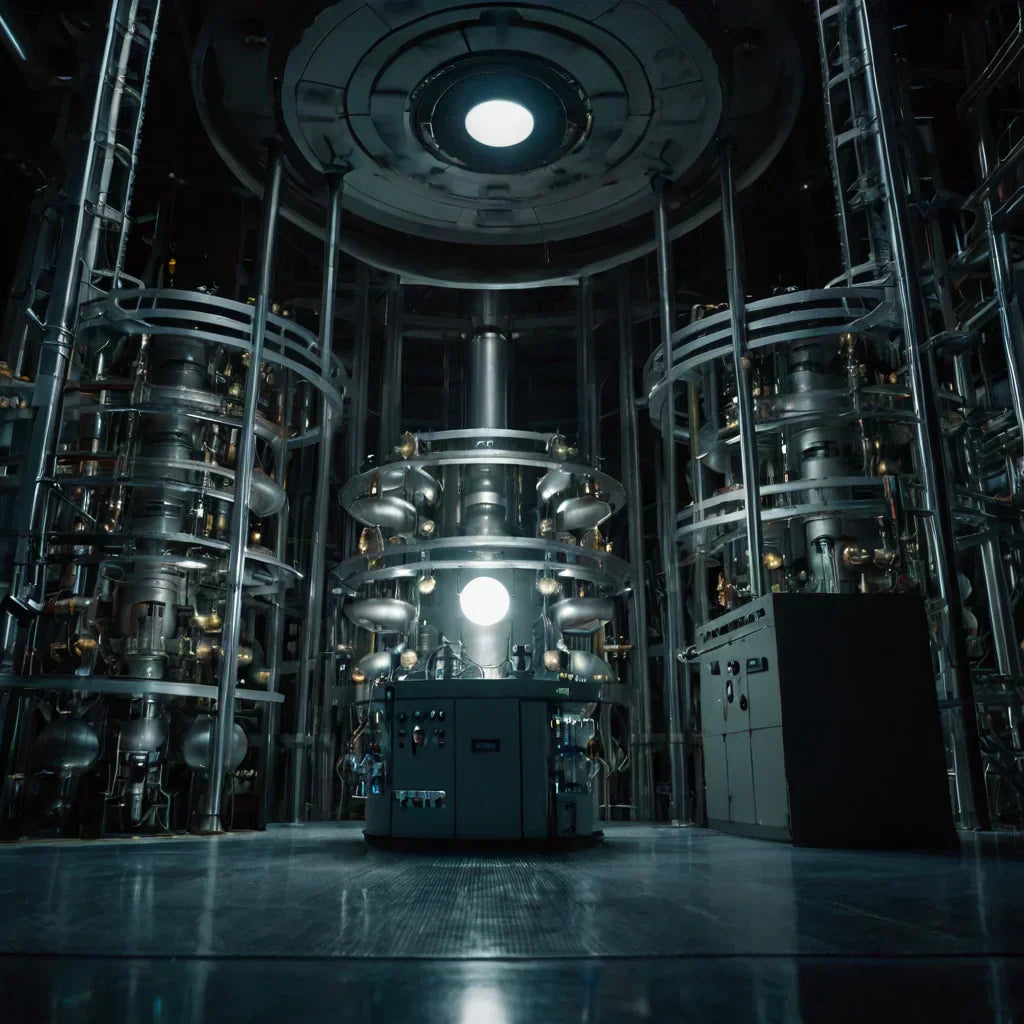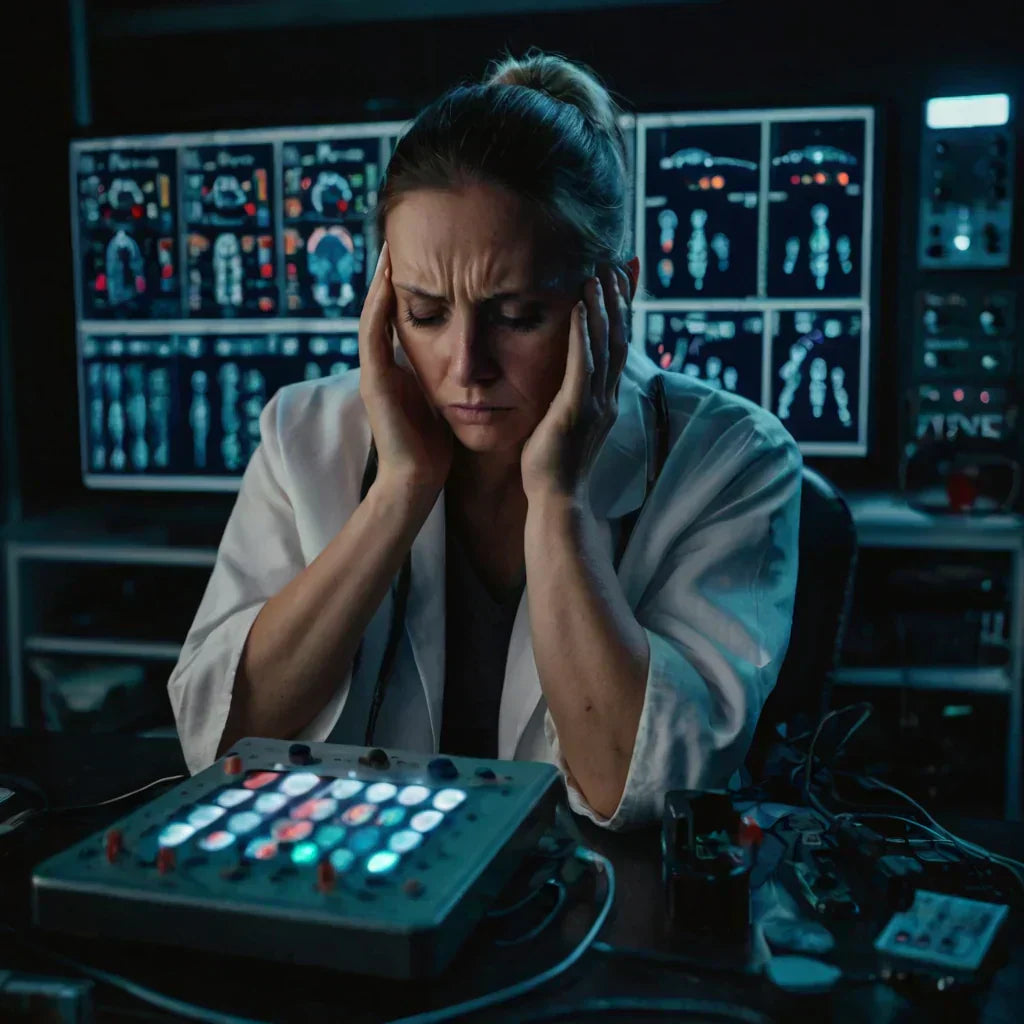At the core of modern energy production, an atom reactor, or nuclear reactor, harnesses the power of nuclear fission. This article will explain what an atom reactor is, how it works, and why it is vital for generating electricity and other essential applications.
Key Takeaways
-
An atom reactor, also known as a nuclear reactor, initiates and controls a fission nuclear chain reaction to generate electricity and produce isotopes for various applications.
-
The development of nuclear reactors began in the 1930s, culminating in the first successful reactor, Chicago Pile-1, which achieved a controlled nuclear chain reaction in 1942.
-
Modern nuclear reactors incorporate multiple safety features, such as containment structures and reactivity feedback mechanisms, to ensure safe operation and mitigate risks of accidents.
What is an Atom Reactor?

A nuclear reactor, also known as an atom reactor, is designed to commence and manage a nuclear chain reaction through fission. It utilizes the process of nuclear fission - where heavy atomic nuclei like uranium or plutonium are split into smaller parts, liberating substantial energy in doing so. This energy is predominantly harnessed by commercial power plants to generate nuclear electricity. The heat generated from the controlled fission reaction in the core of the reactor transforms water into steam. This steam then propels turbines that produce electricity.
Nuclear reactors have purposes beyond generating power. They function as critical instruments for research and create radioactive isotopes which are indispensable in both medical and industrial sectors. Whether it’s supplying electrical power through commercial nuclear power plants or facilitating advancements in science and health via research reactors, their uses span a broad spectrum.
Comprehending these intricate devices is key to recognizing their influence on contemporary life.
Historical Development of Atom Reactors
The inception of nuclear reactors traces back to the 1930s, originating with the covert American enterprise known as the Manhattan Project. This initiative aimed at exploiting atomic fission for power.
Prominent scientists such as Arthur Holly Compton, Enrico Fermi, Leo Szilard, and Eugene Wigner were central to this revolutionary project.
On December 1st, 1942, Chicago Pile-1—a product of this very project—was completed. It successfully sustained a controlled nuclear chain reaction on December 2nd. This achievement signified an important advance in harnessing atomic energy.
Following its successful operation, Chicago Pile-1 was dismantled and relocated for safety reasons. The era following World War II witnessed a shift towards peaceful pursuits involving nuclear technology, which led to Argonne National Laboratory’s founding in 1954 with an emphasis on non-military applications of atomic energy. It heralded the dawn of generating electricity via nuclear means and set forth progress toward constructing commercial nuclear power plants that today account for nearly one-tenth of global electrical output.
Beyond just facilitating electric generation capabilities across societies worldwide, there are indeed wider implications including shifts within international relations due to linkages between these initial endeavors leading up to creation of various weaponry associated with the term ‘nuclear’. Equally profound have been enhancements healthcare through utilization radioactive isotopes besides countless contributions scientific domain all emanating foundational work accompanying original reactor concept development illustrating amalgamation intellectual pursuit technological breakthrough quests addressing ongoing demand sustainable forms of energy supply sources.
How Do Atom Reactors Work?

At the core of a nuclear reactor lies the phenomenon of nuclear fission, wherein large atomic nuclei split into smaller parts, releasing substantial energy. This splitting occurs within the reactor core that houses fuel assemblies comprising natural uranium pellets inside metallic tubes with various fuel elements. As each uranium atom divides, it emits neutrons which in turn stimulate more splits among other uranium nuclei, sustaining a continuous series of nuclear chain reactions. To ensure that this process generates consistent heat without unsafe surges, precise regulation is imperative.
To modulate and sustain control over these intense nuclear chain reactions while preserving both safety and operational effectiveness of the reactors, control rods designed to absorb emitted neutrons are utilized. By strategically altering these rod positions within the reactor’s core relative to where they can produce or capture free-flowing neutrons determines how swiftly or slowly said reaction proceeds.
The formidable heat emanating from this meticulously controlled fission activity serves as a catalyst for converting water into steam that propels turbines—a mechanism pivotal for transforming nuclear energy into usable electrical power—illustrating just how integral such reactors are to our global energy systems.
Key Components of Atom Reactors

Nuclear reactors, complex systems with multiple essential parts, function together to produce energy reliably and securely. Key components such as the reactor core, cooling systems, and containment structures each have a crucial function in managing the operation of the reactor—from maintaining a nuclear chain reaction that sustains itself to dispersing heat and containing radioactive substances. Grasping how a nuclear reactor operates is critical for enhancing their efficiency.
Reactor Core
At the center of a nuclear reactor lies the reactor core, which is where the crucial fission process unfolds. This core contains fuel rods packed with fissile substances like uranium oxide organized into structures known as fuel assemblies. A moderator, typically water or graphite, envelops these rods to decelerate neutrons from fission events, bolstering the probability that additional reactions will occur. To modulate and stabilize the reaction rate within this environment, control rods composed of materials that absorb neutrons can be strategically inserted or retracted.
To uphold a steady and controlled nuclear chain reaction within its design parameters, safety measures are paramount in conjunction with energy production objectives for the reactor core’s operation. Operators meticulously adjust both control rod positioning and coolant circulation to secure efficient yet safe functioning of the plant while it generates heat used in producing electricity.
Cooling Systems
Nuclear reactors rely heavily on effective cooling mechanisms to remove heat from the reactor core, preventing potential overheating. In the case of pressurized water reactors (PWRs), common water acts as a dual-purpose agent – both moderating and cooling – by flowing at high pressure through the core of a water cooled reactor.
After absorbing thermal energy, this hot water is transported to a steam generator, functioning as a heat exchanger, where it creates heated pressurized steam. This steam propels the turbines responsible for generating electricity. The success and security of nuclear reactors depend greatly on such cooling systems and their ability to efficiently control heat within the system’s confines while maintaining optimal thermal efficiency in both nuclear reactions and power generation processes.
Containment Structures
Robust buildings known as containment structures are constructed to hinder the escape of radioactive substances into the environment during significant incidents. These fortifications, composed of dense concrete and steel, act as a sturdy barricade that maintains the reactor’s integrity in extreme emergencies.
The development and assembly of these containment structures are crucial components of safety protocols within nuclear reactor operations.
Types of Atom Reactors

Various kinds of nuclear reactors exist, each featuring distinct designs and methods of operation. Pressurized Water Reactors (PWR) and Boiling Water Reactors (BWR) are the most prevalent forms, responsible for producing a significant portion of global nuclear electricity. A power reactor that harnesses nuclear energy is an integral component within this domain.
Alongside these traditional configurations, cutting-edge developments such as Small Modular Reactors (SMRs) are being introduced. These innovative reactors come with improvements in safety measures and efficiency characteristics.
Pressurized Water Reactors (PWR)
Pressurized water reactors (PWRs) stand as the predominant type of nuclear reactor utilized for generating power in nuclear power plants. These reactors operate by employing regular water to serve dual roles – acting both as a moderator and a coolant that travels under considerable pressure through the reactor core, capturing heat generated by the fission process. This heated water is transferred into pipes within a heat exchanger where it transforms into steam, which then propels turbines to create electricity. The maintained high pressure ensures that boiling does not occur within the reactor core itself, thereby facilitating effective heat transfer. Within this framework, light water reactors are an essential subset.
Key among PWR safety mechanisms is their inherent negative feedback from steam production. This feature plays a crucial role in sustaining stability across various operational states. They can incorporate an additional shutdown system via boron injection into the primary cooling loop if necessary—augmenting safety measures even further. Pressurized water reactors are reputed for their solid construction and dependable functionality. Thus they have become highly sought after for use in commercial nuclear power plants worldwide.
Boiling Water Reactors (BWR)
Boiling water reactors (BWRs) utilize a distinct operational principle compared to Pressurized Water Reactors (PWRs). The design of BWRs allows for the heating of water within the reactor vessel itself, which leads to the generation of steam that propels turbines. As they function at lower pressure levels, this permits boiling directly in the reactor core – a process that streamlines reactor architecture and can enhance efficiency for specific uses.
BWR systems provide an operational advantage by permitting output modulation through variations in coolant flow rate. This feature adds flexibility to their power production capabilities. Following its role in turbine activation, any remaining steam is converted back into water and re-entered into circulation. This promotes effective resource utilization. Consequently, these characteristics render BWR technology suitable across diverse nuclear power applications.
Advanced Reactor Designs
Innovative Small Modular Reactors (SMRs) are at the forefront of nuclear power technology, offering updated features and enhanced safety measures. These compact reactors have a reduced size and increased adaptability compared to traditional power reactors, delivering roughly a third of the energy capacity typically produced by conventional commercial reactors. SMRs hold potential for varied applications such as producing electricity or supporting industrial activities in isolated locations.
The development of Generation IV nuclear reactor designs is focused on improving aspects like safety enhancements, waste reduction, and bolstering resistance against proliferation. They feature closed nuclear fuel cycles that can recycle long-lived actinides with an aim to initiate operation in commercial settings by the year 2030 while remaining considerate towards complete management of the nuclear fuel cycle.
As research continues to advance these technologies, it’s becoming clear that advanced reactor designs will significantly influence future global energy solutions through their integration into our expanding energy infrastructure.
Applications of Atom Reactors
Nuclear reactors serve multiple functions across various sectors. They are primarily employed to generate electric power through nuclear fission, which involves utilizing the heat generated to convert water into steam that propels turbines and generates electricity. This mechanism is crucial for commercial nuclear power plants around the globe, as they supply a considerable amount of global electricity.
To energy generation, these reactors play a critical role in healthcare by producing radioisotopes necessary for diagnostic procedures and cancer therapies. They are also integral to powering naval vessels such as submarines and aircraft carriers with dependable long-term propulsion systems – an important aspect of the broader nuclear industry.
Research reactors are vital assets in scientific advancement because they facilitate experimental studies while generating isotopes used in diverse industrial purposes. Nuclear reactors can even support desalination initiatives, providing essential fresh water supplies in regions faced with scarce natural resources.
Safety Measures in Atom Reactors

The importance of safety in managing nuclear reactors is paramount. To prevent mishaps and contain their impact, modern reactors are fortified with various protective systems. For instance, they feature containment structures—sturdy edifices composed of reinforced concrete and steel designed to retain radioactive materials in case of emergencies. Devices specifically intended for core melt localization are incorporated to intercept and secure any molten reactor core material from breaching the containment area during extreme accidents.
To enhance reactor safety Mechanisms like negative-reactivity feedback come into play by automatically lowering power output if there’s a reduction in coolant density. This decrease leads to an increase in neutron leakage coupled with a dip in reactivity. Consequently, producing fewer neutrons alongside delayed neutrons.
Safety equipment such as the Milerd HiStand contributes crucially to individual protection by monitoring radiation levels continuously and issuing warnings when these levels exceed acceptable limits. With these extensive precautions, nuclear reactors operate under rigorous safety protocols that safeguard both environmental integrity and public health. For more updates and news on radiation safety, visit Milerd.
The Future of Atom Reactors
The outlook for nuclear reactors appears promising, with forecasts suggesting a substantial upsurge in worldwide nuclear energy capacity by 2050 to achieve carbon neutrality. Over two dozen nations are exploring the prospects of adopting nuclear power as they seek solutions for their electricity and environmental concerns, appreciating its ability to offer consistent and eco-friendly power supply. As reported by the World Nuclear Association, around 10% of global electrical generation is currently produced by nuclear power plants operating across thirty countries.
Small Modular Reactors (SMRs) represent a breakthrough in reactor technology and are anticipated to be instrumental in this growth phase. These state-of-the-art reactors come with advantages such as enhanced safety measures, cost efficiency, and reduced construction durations that render them an attractive choice for forthcoming energy initiatives.
There’s an ongoing endeavor to prolong the service life of active reactors from four decades to six, which underlines the enduring significance and dependability of atomic energy sources. Sustainability at its core. It’s evident that atom-powered installations will continue playing a vital role within our planet’s diverse range of renewable resources.
Milerd HiStand: Ensuring Personal Safety Near Atom Reactors

The importance of individual safety in the vicinity of nuclear reactors cannot be overstated, and the Milerd HiStand has been developed as a state-of-the-art tool to address this necessity. This personal radiation detector is engineered to measure surrounding radiation intensities while providing exceptional reliability through advanced functionality and solid defense mechanisms. It boasts water resistance and resilience against impacts, guaranteeing its longevity across different settings. A built-in solar panel on the device enhances its sustainability by enabling prolonged self-sufficient operation without requiring regular battery recharges.
Equipped with capabilities for monitoring daily exposure to radiation, the HiStand provides timely notifications when predefined limits are exceeded, offering instantaneous information about prevailing radiation magnitudes. It permits users to review comprehensive logs of their exposure history that record peak levels of background radiation encountered along with an aggregate dosage received each day. It preserves these details for a period extending up to one month.
Augmenting the utility provided by this apparatus is Milerd’s PORT desktop software—transformative in enhancing what can be achieved using the detector—and rendering it indispensable not only for professionals working proximate to or those vigilant regarding potential risks from nuclear reactor-emitted radiations but also for individuals mindful about such hazards generally.
Summary
In essence, nuclear reactors are formidable instruments that have transformed the landscape of energy generation, medical procedures, and scholarly investigation. Since their inception during the Manhattan Project to their current applications in contemporary nuclear power facilities, these reactors have significantly influenced multiple industries. A thorough grasp of how they operate, including an understanding of their essential parts and the various models available, is vital for appreciating both their significance and operational mechanisms.

As we look to what’s ahead, there’s optimism surrounding the evolution of nuclear reactor technology with ongoing enhancements in design complexity, and expansion in worldwide capacity for power production using atomic energy methods like Small Modular Reactors (SMRs). This progression points towards a more sustainable future concerning energy resources. Concurrently, safety protocols are being refined consistently to assure safe utilization of these potent entities. Devices specifically designed for protection from radiation such as Milerd HiStand provide sophisticated surveillance against radiation threats ensuring individual security continues robustly amid developing challenges and prospects where atomic reactions serve as a pivotal component within technological advancement and electricity supply systems.



Laat een reactie achter
Deze site wordt beschermd door hCaptcha en het privacybeleid en de servicevoorwaarden van hCaptcha zijn van toepassing.